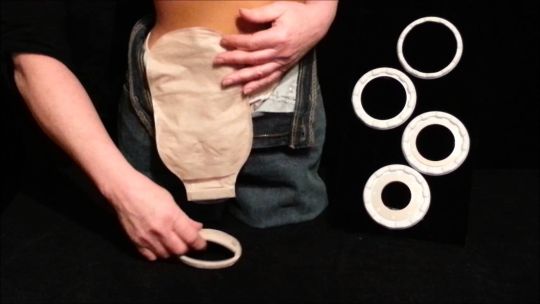Don't wanna be here? Send us removal request.
Text
What Is An Ileostomy?
A surgically created bowel diversion that allows bodily wastes to leave the body without proceeding to the colon is known as an ileostomy. This bowel diversion includes an opening (stoma) that the surgeon creates by bringing the end of the small intestine through a cut in the belly.

The doctor may recommend an ileostomy when he finds it appropriate to remove or rest the entire colon. It can be permanent or temporary, depending on the severity or type of condition that necessitates an ileostomy. The doctor will recommend a temporary ileostomy if your colon needs to rest in order to recover. It provides the colon with the required amount of time to regain its health.
In certain conditions, the colon might not remain treatable. In those circumstances, the surgeon will want to remove the colon permanently. The resultant ileostomy will be permanent in those cases.
youtube
Diagnosis and preparation
This phase involves the patient meeting with the surgeon to discuss details about the surgery and postoperative care. This meeting allows the patient to clear any doubts about the procedure and its impact on life afterward. During this meeting, the ostomy care nurse marks the stoma site.
The surgeon performs surgery after putting the patient to sleep by administrating general anesthesia through an intravenous line. The patient may have to prepare bowels before surgery by taking laxatives and other medications.
Aftercare

The patient has to remain hospitalized for a few days after surgery. During this stay, an ostomy care nurse visits the patient’s room regularly to discuss ostomy care, which includes placing an ileostomy bag, caring for the stoma, and making necessary changes to diet to encourage a quicker recovery.
Risks
Complications can occur during or after ileostomy surgery. These risks are generally related to poor ostomy care and ileostomy procedure. The ones associated with the surgical procedure may include infection, excessive bleeding, and problems due to general anesthesia. Complications that can occur after surgery may include obstruction, inflammation, irritation in the peristomal skin area, and stoma prolapse.
Impact on life

An ileostomy doesn’t affect the quality of life after the postoperative recovery. The patient can eat whatever he wants and engage in physical activities. Many patients, however, suffer from the psychological impact of surgery.
Alternatives
In many cases, ulcerative colitis, which is the leading cause of the most ileostomies, is mild enough to be treatable through medications. These medications aim at treating the impact of ulcerative colitis and eliminating its root cause. Some medications may leave an impact on the immune system.
In some cases, the doctor may recommend a surgical alternative to an ileostomy. This alternative generally involves the creation of an ileoanal reservoir inside the abdomen. The doctor will recommend this procedure when your anus and its sphincters are intact. The surgeon will create a pouch by folding the end of the small intestine into itself. He will then make an incision at the bottom of that pouch, and place it over the anus. This internal reservoir allows you to pass waste contents through your anus. Initially, you may have to go to the toilet 6-8 times a day, but this frequency will reduce when your bowel adapts to its new length. You can talk to your doctor whether or not you are the right candidate for an ileoanal reservoir.
2 notes
·
View notes
Text
Ileostomy - Types of Ileostomies - and Pouching System
What is Ileostomy?
An ileostomy is a surgical opening of a hole in the abdomen due to the removal of the ileum or small intestine. A defect, disease, blockage in the small intestine can lead to ileostomy surgery. It releases a liquid form of stool which is a solid waste of a human body. It can be in the shape of diarrhea, loose motion, or simple liquid stool. It appears on the right side of the abdomen. Moreover, sometimes an ileostomy is a temporary process, while in some severe cases it will be permanent.

A person when diagnosed with a chronic disease in the ileum, small intestine, dysfunctioning of the small intestine, rectum cancer, radiation treatment as a result of cancer, a birth defect in the ileum, injuries in the small intestine, bowel disease, or Hirschsprung’s disease, then doctors perform ileostomy. As a result of the ileostomy surgery, a patient discharges a liquid form of feces through the hole in the abdomen, called a stoma. The round opening covers a pouching system to hold the waste. It requires a stoma bag or pouch to collect the liquid form of stool. Usually, a drainable pouching system is used to hold the discharge, it is easy to wear and empty. It makes an ileostomy patient comfortable and replacing, cleaning, and draining is effortless.
Types of Ileostomy
An ileostomy type depends on the seriousness of the diseases, the dysfunction part of the small intestine, and the treatment. Therefore, the following are the kinds of ileostomy.
Temporary Ileostomy
The temporary ileostomy is reversing the ileum to its previous destination after the healing of the disease. In this surgery, doctors put the bowel on rest for a certain time and remove the defected part of the bowel or small intestine (ileum). Once the damage and disease recover, surgeons bring the ileum back to the previous location, and the bowel and small intestine perform their functions. In the initial stage of diseases, doctors do ileoanal reservoir or J-pouch methods of ileostomy operations.
Permanent Ileostomy

In the permanent ileostomy, a stoma remains forever on the patient's abdomen. It collects the liquid stool in a stoma bag for the rest of the life. In this surgery, a bowel adopts an inert position and cannot perform its function anymore. This happens when there is a severe disease in the small intestine and bowel. Thus, the anus does not perform its duty and passes its responsibility to the stoma.
Standard or Brooke Ileostomy
In the standard or Brook ileostomy, the last section or end of the small intestine bring to the abdominal round opening. This appears on the lower right side of the belly button. Moreover, the stoma created on the abdominal wall is round, smooth, and red. Furthermore, in this operation, the movement of the bowel and release of liquid stool is uncontrollable and unpredictable. Therefore, a patient must have to wear a drainable pouch.
Continent Ileostomy
The continent ileostomy performs as a result of Ulcerative colitis, Familial polyposis, ileum cancer, and rectal cancer. The opening of the continent ileostomy needs a cover and a catheter tube for the drainage of the liquid stool. In this type, a patient does need to wear an external stoma bag; therefore, a reservoir or pocket has formed in the inside of the patient's abdomen. It has a nipple valve, and an ostomate has to put the tube in that for drainage.
Ileoanal Reservoir
Ileoanal reservoir, J-pouch, or pelvic pouch happens because of the diseases in the ileum like Ulcerative colitis and Familial polyposis. The stoma excretes a soft formed stool and it needs a cover and bag to collect the waste. Moreover, the anus and skin around it become sensitive; therefore, an ostomate has to take care of that part.
youtube
0 notes